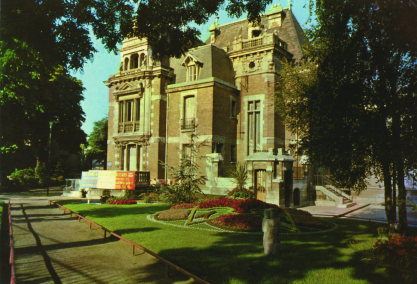La Galerie: context and history
The context: Noisy-le-Sec
Noisy-le-Sec is a municipality of some 40,000 people in the Seine-Saint-Denis département, 9.5 kilometres from Paris.
During the Second World War Noisy-le-Sec, and especially its railway yards, suffered massive Allied bombing aimed at undermining Germany’s logistics. Damage to property was enormous and the La Galerie building was one of the few to survive unscathed. Noisy-le-Sec was officially declared a disaster area on 5 August 1944; its reconstruction made it a Ministry of Town Planning testing ground and it was the site of the Cité Expérimentale de Merlan competition in 1946: seven countries – France, the United States, Canada, Great Britain, Finland, Sweden and Switzerland – took part in the project, which called for mass-production building procedures for housing that would be sound, comfortable, large-scale and cheap. The aim at this period was to build very fast, which meant rationalising and standardising architectural procedures; these years also saw the first “slab blocks”, which brought radical change to the landscape of the Paris outskirts. In Noisy-le-Sec the Cité des Aviateurs housing estate was built between 1955 and 1960; combining rapidity and economy, this social housing block served as the prototype for most of the suburban housing estates of the time. According to a 2005 survey, the municipality comprises almost 41% social housing.
On 1 January 2009 Noisy-le-Sec became part of the “Est Ensemble” (East United) urban community, which also includes the municipalities of Bagnolet, Bobigny, Bondy, Le Pré-Saint-Gervais, Les Lilas, Montreuil, Romainville and Pantin.
In addition the Seine-Saint-Denis département will soon be incorporated into the Grand Paris metropolitan development area.
The La Galerie building
Built in 1880 by architect Charles Barrois, the building began life as the home of Noisy-le-Sec’s notary public. In 1913 it was acquired by the municipality for various state services: the taxation office, apprenticeship classes, a justice of the peace, and the issuing of tax stamps and permits. During the First World War it was requisitioned as a local military hospital before becoming an official evacuation hospital.
After the First World War the building was home to the public library and the local prehistory museum. Spared by Second World War bombing, it housed certain municipal departments; in 1945 the library moved back in and remained until the opening of the Roger Gouhier media library in 1998. It was then refurbished as a centre for contemporary art.
La Galerie centre for contemporary art
Since its founding La Galerie has been financed by the City of Noisy-le-Sec, with additional backing from the Ministry of Culture and Communication (via the Ile-de-France Region Cultural Affairs Office), the Seine-Saint-Denis Département and the Ile-de-France Region. Since January 2005 it has been directly managed by the City of Noisy-le-Sec Cultural Affairs Department.
La Galerie engages in numerous collaborative ventures with Noisy-le-Sec’s cultural service departments, the Roger Gouhier media library, the Intermunicipal Music and Dance Conservatory, the Théâtre des Bergeries and the Trianon intermunicipal art cinema.
La Galerie’s first director was Hélène Chouteau (1999–2004). She was followed by Marianne Lanavère (January 2005–March 2012) and Émilie Renard (September 2012–August 2018).



